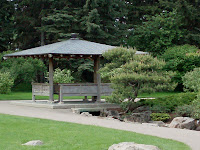

Sunday we visited the Japanese Gardens.
We were escorted into the garden by a guide dressed in yukata. The pathway symbolizes a red carpet. We were told we were considered as royalty, just for the day.
Come for a walk through the garden.
We began with the pavilion, built in traditional Japanese style with no nails. Nikka Yuko's pavilion is patterned on sixteenth century architecture, built and designed for Royalty and/or privileged. It is used here for special occasions. Usually paper would be used in the screen doors and windows, however because Lethbridge is so windy they used plastic.

To the right inside the wall, is the rock or meditation garden, usually found beside Zen monasteries. It is a dry garden which consists of rocks and sand with raked patterns, used for meditation and reflection. The monks would create a new pattern early in the morning and meditate on these patterns for most of the day.

There are no flowers planted in this garden as they provide a distraction. This is a garden of peace and tranquility, quiet beauty and culture.
It is called a hidden garden because you can not see the whole of the garden from one vantage point.
The five tiered Pagoda has specific meaning in the Japanese culture. From bottom to top the tiers symbolize earth, water, fire, wind and sky or space.
Azumaya means resting place. Here the path separates into two, and as in life, you must contemplate and choose your path.
On the paths around the garden you can hear the sounds of water running through the streams and over the waterfalls.
The Ceremonial Friendship Bell. This bell was especially cast as a friendship bell in Japan. It is made of bronze and weighs approximately 2/3 tonne. In Japan this type of bell is used only as a temple bell.
...and back to the front gate.













No comments:
Post a Comment